Business Law: Comprehensive Overview of Malaysian Legal System Sources
VerifiedAdded on 2021/04/21
|14
|4243
|29
Report
AI Summary
This report provides a detailed analysis of the Malaysian legal system, exploring its historical background and the influence of British colonization, which led to a mixed legal system comprising common law, customary law, and Islamic law. The report highlights the dual system encompassing both Sharia and secular laws. It delves into the sources of Malaysian law, categorizing them into written and unwritten laws. Written laws include the Federal Constitution, State Constitutions, legislation enacted by Parliament and State Assemblies, and subsidiary legislation. The unwritten laws consist of English law (common law and equity), judicial decisions, and customs. The report explains the application of these sources, emphasizing the importance of the Federal Constitution as the supreme law. It also discusses the role of English law, particularly in commercial matters, and the adaptation of these laws to meet local needs. The report cites relevant cases, such as Eng Keock Cheng v. Public Prosecutor and Commonwealth of Australia v Midford (Malaysia) Sdn Bhd, to illustrate the application of legal principles and the development of the Malaysian legal system.
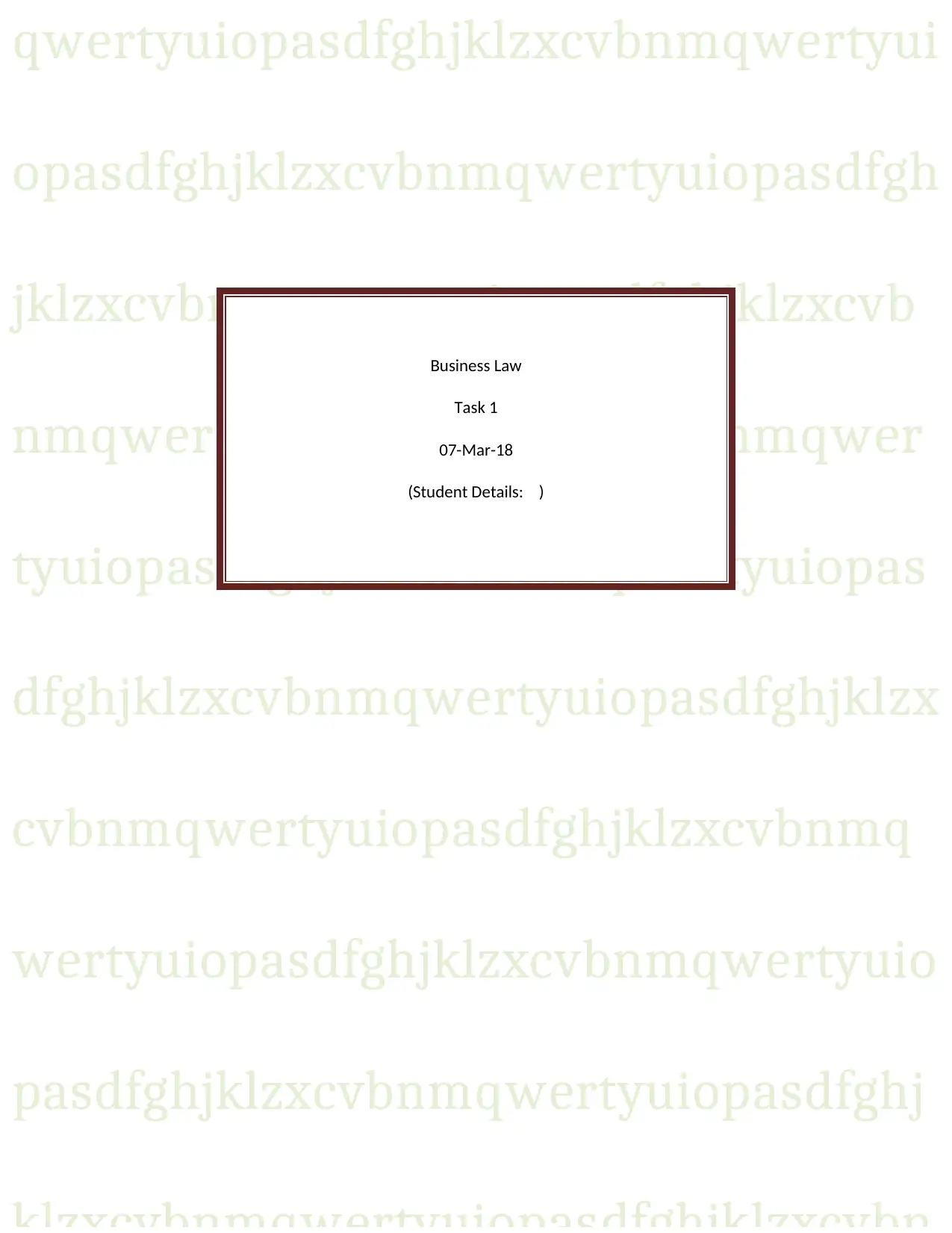
qwertyuiopasdfghjklzxcvbnmqwertyui
opasdfghjklzxcvbnmqwertyuiopasdfgh
jklzxcvbnmqwertyuiopasdfghjklzxcvb
nmqwertyuiopasdfghjklzxcvbnmqwer
tyuiopasdfghjklzxcvbnmqwertyuiopas
dfghjklzxcvbnmqwertyuiopasdfghjklzx
cvbnmqwertyuiopasdfghjklzxcvbnmq
wertyuiopasdfghjklzxcvbnmqwertyuio
pasdfghjklzxcvbnmqwertyuiopasdfghj
Business Law
Task 1
07-Mar-18
(Student Details: )
opasdfghjklzxcvbnmqwertyuiopasdfgh
jklzxcvbnmqwertyuiopasdfghjklzxcvb
nmqwertyuiopasdfghjklzxcvbnmqwer
tyuiopasdfghjklzxcvbnmqwertyuiopas
dfghjklzxcvbnmqwertyuiopasdfghjklzx
cvbnmqwertyuiopasdfghjklzxcvbnmq
wertyuiopasdfghjklzxcvbnmqwertyuio
pasdfghjklzxcvbnmqwertyuiopasdfghj
Business Law
Task 1
07-Mar-18
(Student Details: )
Paraphrase This Document
Need a fresh take? Get an instant paraphrase of this document with our AI Paraphraser
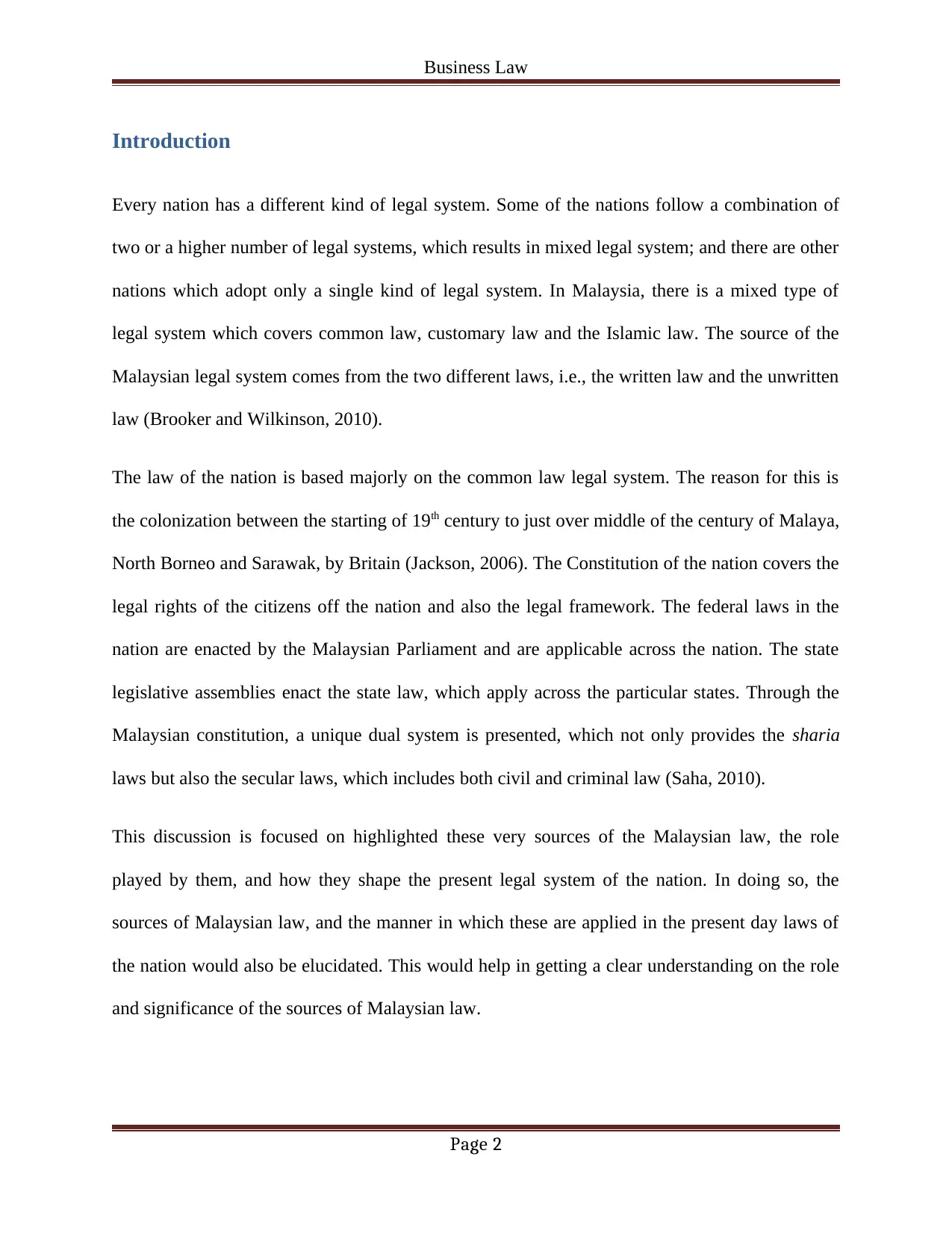
Business Law
Introduction
Every nation has a different kind of legal system. Some of the nations follow a combination of
two or a higher number of legal systems, which results in mixed legal system; and there are other
nations which adopt only a single kind of legal system. In Malaysia, there is a mixed type of
legal system which covers common law, customary law and the Islamic law. The source of the
Malaysian legal system comes from the two different laws, i.e., the written law and the unwritten
law (Brooker and Wilkinson, 2010).
The law of the nation is based majorly on the common law legal system. The reason for this is
the colonization between the starting of 19th century to just over middle of the century of Malaya,
North Borneo and Sarawak, by Britain (Jackson, 2006). The Constitution of the nation covers the
legal rights of the citizens off the nation and also the legal framework. The federal laws in the
nation are enacted by the Malaysian Parliament and are applicable across the nation. The state
legislative assemblies enact the state law, which apply across the particular states. Through the
Malaysian constitution, a unique dual system is presented, which not only provides the sharia
laws but also the secular laws, which includes both civil and criminal law (Saha, 2010).
This discussion is focused on highlighted these very sources of the Malaysian law, the role
played by them, and how they shape the present legal system of the nation. In doing so, the
sources of Malaysian law, and the manner in which these are applied in the present day laws of
the nation would also be elucidated. This would help in getting a clear understanding on the role
and significance of the sources of Malaysian law.
Page 2
Introduction
Every nation has a different kind of legal system. Some of the nations follow a combination of
two or a higher number of legal systems, which results in mixed legal system; and there are other
nations which adopt only a single kind of legal system. In Malaysia, there is a mixed type of
legal system which covers common law, customary law and the Islamic law. The source of the
Malaysian legal system comes from the two different laws, i.e., the written law and the unwritten
law (Brooker and Wilkinson, 2010).
The law of the nation is based majorly on the common law legal system. The reason for this is
the colonization between the starting of 19th century to just over middle of the century of Malaya,
North Borneo and Sarawak, by Britain (Jackson, 2006). The Constitution of the nation covers the
legal rights of the citizens off the nation and also the legal framework. The federal laws in the
nation are enacted by the Malaysian Parliament and are applicable across the nation. The state
legislative assemblies enact the state law, which apply across the particular states. Through the
Malaysian constitution, a unique dual system is presented, which not only provides the sharia
laws but also the secular laws, which includes both civil and criminal law (Saha, 2010).
This discussion is focused on highlighted these very sources of the Malaysian law, the role
played by them, and how they shape the present legal system of the nation. In doing so, the
sources of Malaysian law, and the manner in which these are applied in the present day laws of
the nation would also be elucidated. This would help in getting a clear understanding on the role
and significance of the sources of Malaysian law.
Page 2
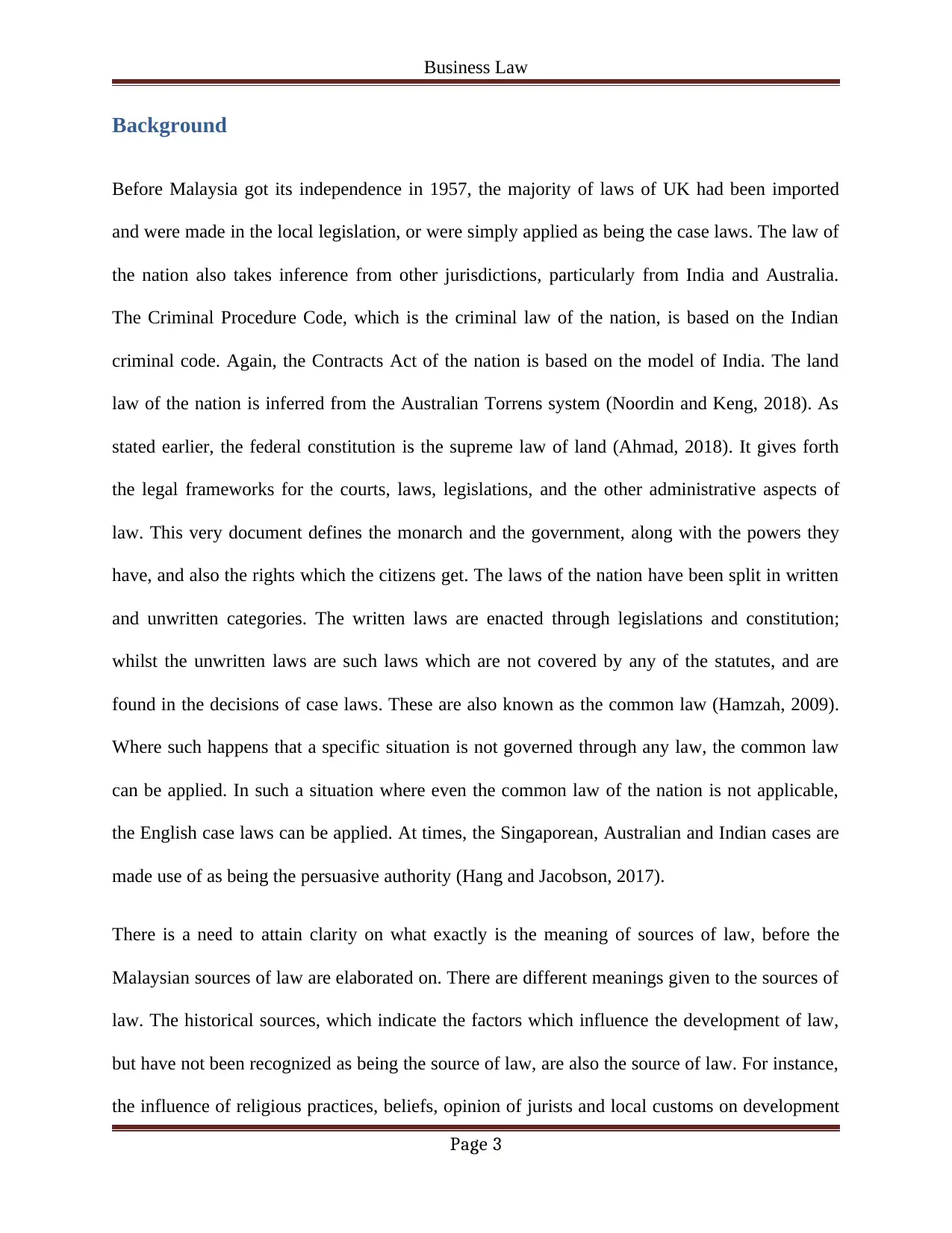
Business Law
Background
Before Malaysia got its independence in 1957, the majority of laws of UK had been imported
and were made in the local legislation, or were simply applied as being the case laws. The law of
the nation also takes inference from other jurisdictions, particularly from India and Australia.
The Criminal Procedure Code, which is the criminal law of the nation, is based on the Indian
criminal code. Again, the Contracts Act of the nation is based on the model of India. The land
law of the nation is inferred from the Australian Torrens system (Noordin and Keng, 2018). As
stated earlier, the federal constitution is the supreme law of land (Ahmad, 2018). It gives forth
the legal frameworks for the courts, laws, legislations, and the other administrative aspects of
law. This very document defines the monarch and the government, along with the powers they
have, and also the rights which the citizens get. The laws of the nation have been split in written
and unwritten categories. The written laws are enacted through legislations and constitution;
whilst the unwritten laws are such laws which are not covered by any of the statutes, and are
found in the decisions of case laws. These are also known as the common law (Hamzah, 2009).
Where such happens that a specific situation is not governed through any law, the common law
can be applied. In such a situation where even the common law of the nation is not applicable,
the English case laws can be applied. At times, the Singaporean, Australian and Indian cases are
made use of as being the persuasive authority (Hang and Jacobson, 2017).
There is a need to attain clarity on what exactly is the meaning of sources of law, before the
Malaysian sources of law are elaborated on. There are different meanings given to the sources of
law. The historical sources, which indicate the factors which influence the development of law,
but have not been recognized as being the source of law, are also the source of law. For instance,
the influence of religious practices, beliefs, opinion of jurists and local customs on development
Page 3
Background
Before Malaysia got its independence in 1957, the majority of laws of UK had been imported
and were made in the local legislation, or were simply applied as being the case laws. The law of
the nation also takes inference from other jurisdictions, particularly from India and Australia.
The Criminal Procedure Code, which is the criminal law of the nation, is based on the Indian
criminal code. Again, the Contracts Act of the nation is based on the model of India. The land
law of the nation is inferred from the Australian Torrens system (Noordin and Keng, 2018). As
stated earlier, the federal constitution is the supreme law of land (Ahmad, 2018). It gives forth
the legal frameworks for the courts, laws, legislations, and the other administrative aspects of
law. This very document defines the monarch and the government, along with the powers they
have, and also the rights which the citizens get. The laws of the nation have been split in written
and unwritten categories. The written laws are enacted through legislations and constitution;
whilst the unwritten laws are such laws which are not covered by any of the statutes, and are
found in the decisions of case laws. These are also known as the common law (Hamzah, 2009).
Where such happens that a specific situation is not governed through any law, the common law
can be applied. In such a situation where even the common law of the nation is not applicable,
the English case laws can be applied. At times, the Singaporean, Australian and Indian cases are
made use of as being the persuasive authority (Hang and Jacobson, 2017).
There is a need to attain clarity on what exactly is the meaning of sources of law, before the
Malaysian sources of law are elaborated on. There are different meanings given to the sources of
law. The historical sources, which indicate the factors which influence the development of law,
but have not been recognized as being the source of law, are also the source of law. For instance,
the influence of religious practices, beliefs, opinion of jurists and local customs on development
Page 3
⊘ This is a preview!⊘
Do you want full access?
Subscribe today to unlock all pages.

Trusted by 1+ million students worldwide
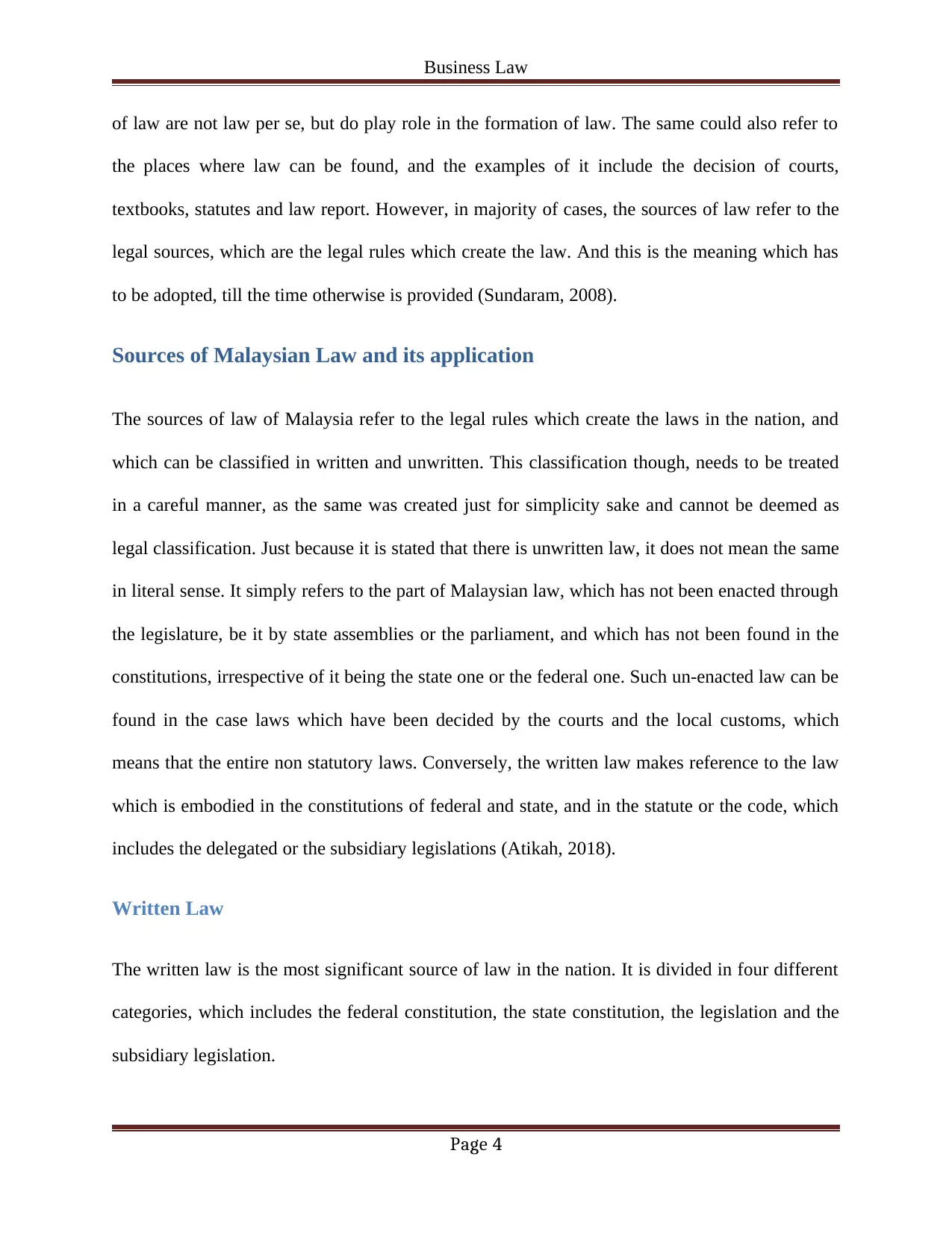
Business Law
of law are not law per se, but do play role in the formation of law. The same could also refer to
the places where law can be found, and the examples of it include the decision of courts,
textbooks, statutes and law report. However, in majority of cases, the sources of law refer to the
legal sources, which are the legal rules which create the law. And this is the meaning which has
to be adopted, till the time otherwise is provided (Sundaram, 2008).
Sources of Malaysian Law and its application
The sources of law of Malaysia refer to the legal rules which create the laws in the nation, and
which can be classified in written and unwritten. This classification though, needs to be treated
in a careful manner, as the same was created just for simplicity sake and cannot be deemed as
legal classification. Just because it is stated that there is unwritten law, it does not mean the same
in literal sense. It simply refers to the part of Malaysian law, which has not been enacted through
the legislature, be it by state assemblies or the parliament, and which has not been found in the
constitutions, irrespective of it being the state one or the federal one. Such un-enacted law can be
found in the case laws which have been decided by the courts and the local customs, which
means that the entire non statutory laws. Conversely, the written law makes reference to the law
which is embodied in the constitutions of federal and state, and in the statute or the code, which
includes the delegated or the subsidiary legislations (Atikah, 2018).
Written Law
The written law is the most significant source of law in the nation. It is divided in four different
categories, which includes the federal constitution, the state constitution, the legislation and the
subsidiary legislation.
Page 4
of law are not law per se, but do play role in the formation of law. The same could also refer to
the places where law can be found, and the examples of it include the decision of courts,
textbooks, statutes and law report. However, in majority of cases, the sources of law refer to the
legal sources, which are the legal rules which create the law. And this is the meaning which has
to be adopted, till the time otherwise is provided (Sundaram, 2008).
Sources of Malaysian Law and its application
The sources of law of Malaysia refer to the legal rules which create the laws in the nation, and
which can be classified in written and unwritten. This classification though, needs to be treated
in a careful manner, as the same was created just for simplicity sake and cannot be deemed as
legal classification. Just because it is stated that there is unwritten law, it does not mean the same
in literal sense. It simply refers to the part of Malaysian law, which has not been enacted through
the legislature, be it by state assemblies or the parliament, and which has not been found in the
constitutions, irrespective of it being the state one or the federal one. Such un-enacted law can be
found in the case laws which have been decided by the courts and the local customs, which
means that the entire non statutory laws. Conversely, the written law makes reference to the law
which is embodied in the constitutions of federal and state, and in the statute or the code, which
includes the delegated or the subsidiary legislations (Atikah, 2018).
Written Law
The written law is the most significant source of law in the nation. It is divided in four different
categories, which includes the federal constitution, the state constitution, the legislation and the
subsidiary legislation.
Page 4
Paraphrase This Document
Need a fresh take? Get an instant paraphrase of this document with our AI Paraphraser
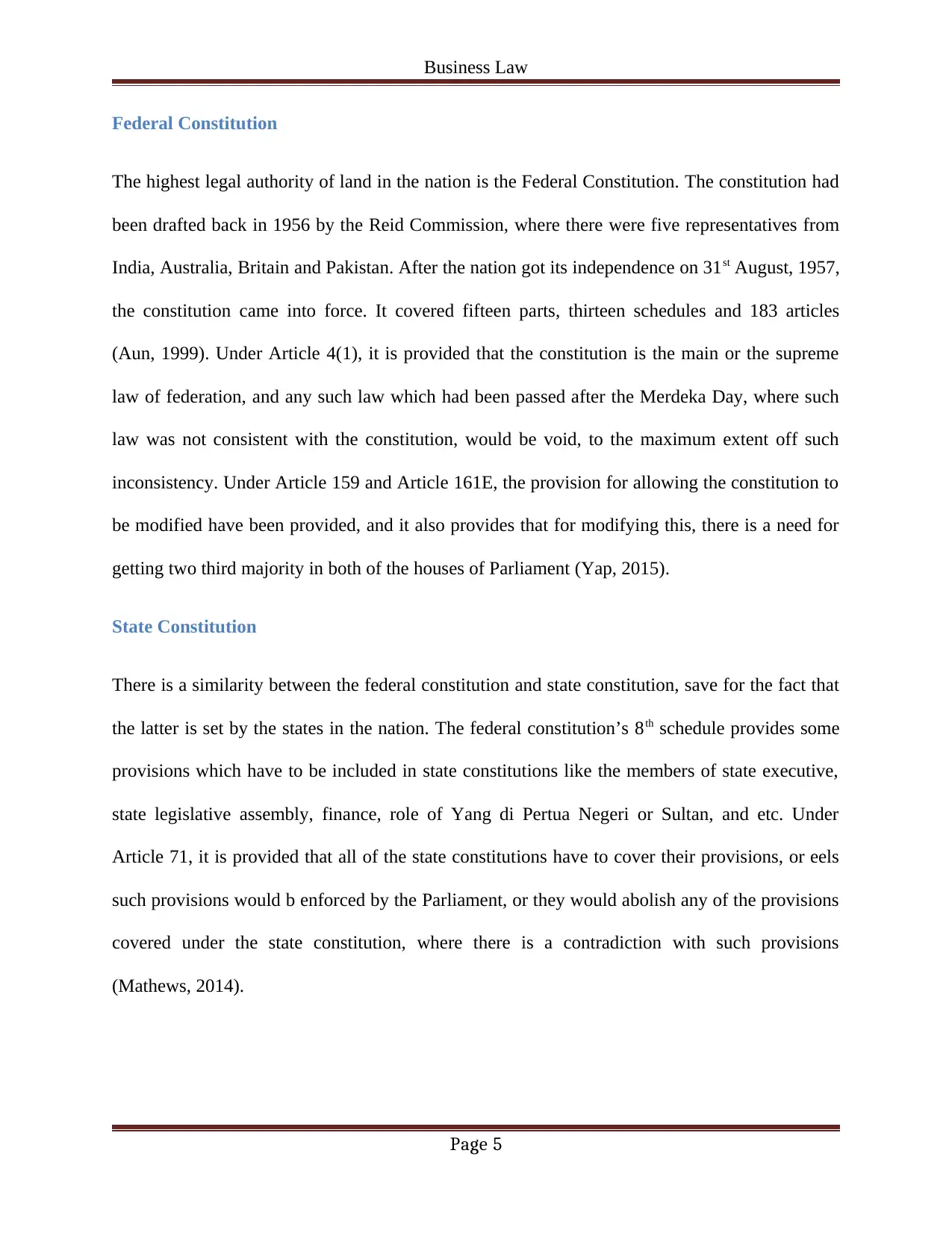
Business Law
Federal Constitution
The highest legal authority of land in the nation is the Federal Constitution. The constitution had
been drafted back in 1956 by the Reid Commission, where there were five representatives from
India, Australia, Britain and Pakistan. After the nation got its independence on 31st August, 1957,
the constitution came into force. It covered fifteen parts, thirteen schedules and 183 articles
(Aun, 1999). Under Article 4(1), it is provided that the constitution is the main or the supreme
law of federation, and any such law which had been passed after the Merdeka Day, where such
law was not consistent with the constitution, would be void, to the maximum extent off such
inconsistency. Under Article 159 and Article 161E, the provision for allowing the constitution to
be modified have been provided, and it also provides that for modifying this, there is a need for
getting two third majority in both of the houses of Parliament (Yap, 2015).
State Constitution
There is a similarity between the federal constitution and state constitution, save for the fact that
the latter is set by the states in the nation. The federal constitution’s 8th schedule provides some
provisions which have to be included in state constitutions like the members of state executive,
state legislative assembly, finance, role of Yang di Pertua Negeri or Sultan, and etc. Under
Article 71, it is provided that all of the state constitutions have to cover their provisions, or eels
such provisions would b enforced by the Parliament, or they would abolish any of the provisions
covered under the state constitution, where there is a contradiction with such provisions
(Mathews, 2014).
Page 5
Federal Constitution
The highest legal authority of land in the nation is the Federal Constitution. The constitution had
been drafted back in 1956 by the Reid Commission, where there were five representatives from
India, Australia, Britain and Pakistan. After the nation got its independence on 31st August, 1957,
the constitution came into force. It covered fifteen parts, thirteen schedules and 183 articles
(Aun, 1999). Under Article 4(1), it is provided that the constitution is the main or the supreme
law of federation, and any such law which had been passed after the Merdeka Day, where such
law was not consistent with the constitution, would be void, to the maximum extent off such
inconsistency. Under Article 159 and Article 161E, the provision for allowing the constitution to
be modified have been provided, and it also provides that for modifying this, there is a need for
getting two third majority in both of the houses of Parliament (Yap, 2015).
State Constitution
There is a similarity between the federal constitution and state constitution, save for the fact that
the latter is set by the states in the nation. The federal constitution’s 8th schedule provides some
provisions which have to be included in state constitutions like the members of state executive,
state legislative assembly, finance, role of Yang di Pertua Negeri or Sultan, and etc. Under
Article 71, it is provided that all of the state constitutions have to cover their provisions, or eels
such provisions would b enforced by the Parliament, or they would abolish any of the provisions
covered under the state constitution, where there is a contradiction with such provisions
(Mathews, 2014).
Page 5
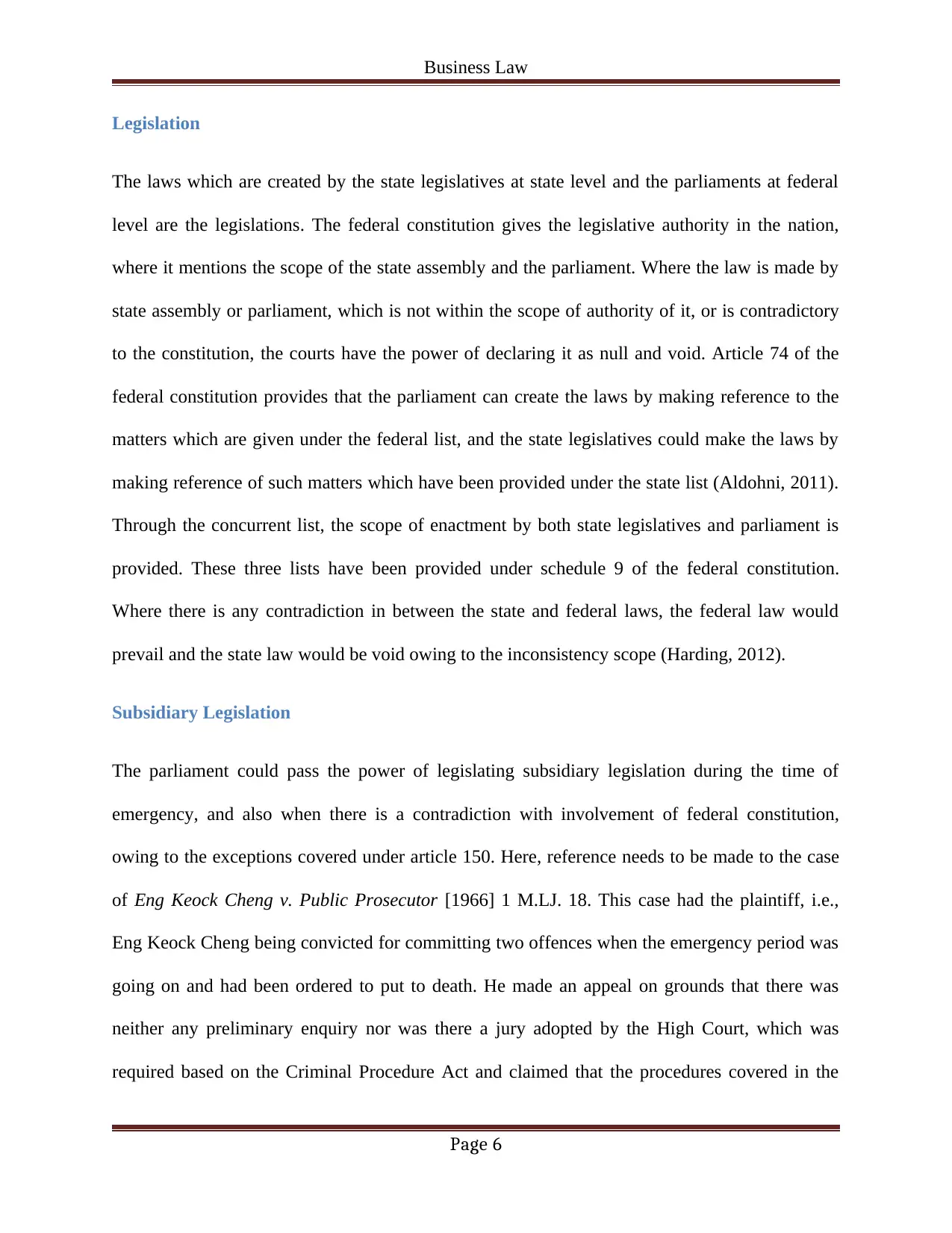
Business Law
Legislation
The laws which are created by the state legislatives at state level and the parliaments at federal
level are the legislations. The federal constitution gives the legislative authority in the nation,
where it mentions the scope of the state assembly and the parliament. Where the law is made by
state assembly or parliament, which is not within the scope of authority of it, or is contradictory
to the constitution, the courts have the power of declaring it as null and void. Article 74 of the
federal constitution provides that the parliament can create the laws by making reference to the
matters which are given under the federal list, and the state legislatives could make the laws by
making reference of such matters which have been provided under the state list (Aldohni, 2011).
Through the concurrent list, the scope of enactment by both state legislatives and parliament is
provided. These three lists have been provided under schedule 9 of the federal constitution.
Where there is any contradiction in between the state and federal laws, the federal law would
prevail and the state law would be void owing to the inconsistency scope (Harding, 2012).
Subsidiary Legislation
The parliament could pass the power of legislating subsidiary legislation during the time of
emergency, and also when there is a contradiction with involvement of federal constitution,
owing to the exceptions covered under article 150. Here, reference needs to be made to the case
of Eng Keock Cheng v. Public Prosecutor [1966] 1 M.LJ. 18. This case had the plaintiff, i.e.,
Eng Keock Cheng being convicted for committing two offences when the emergency period was
going on and had been ordered to put to death. He made an appeal on grounds that there was
neither any preliminary enquiry nor was there a jury adopted by the High Court, which was
required based on the Criminal Procedure Act and claimed that the procedures covered in the
Page 6
Legislation
The laws which are created by the state legislatives at state level and the parliaments at federal
level are the legislations. The federal constitution gives the legislative authority in the nation,
where it mentions the scope of the state assembly and the parliament. Where the law is made by
state assembly or parliament, which is not within the scope of authority of it, or is contradictory
to the constitution, the courts have the power of declaring it as null and void. Article 74 of the
federal constitution provides that the parliament can create the laws by making reference to the
matters which are given under the federal list, and the state legislatives could make the laws by
making reference of such matters which have been provided under the state list (Aldohni, 2011).
Through the concurrent list, the scope of enactment by both state legislatives and parliament is
provided. These three lists have been provided under schedule 9 of the federal constitution.
Where there is any contradiction in between the state and federal laws, the federal law would
prevail and the state law would be void owing to the inconsistency scope (Harding, 2012).
Subsidiary Legislation
The parliament could pass the power of legislating subsidiary legislation during the time of
emergency, and also when there is a contradiction with involvement of federal constitution,
owing to the exceptions covered under article 150. Here, reference needs to be made to the case
of Eng Keock Cheng v. Public Prosecutor [1966] 1 M.LJ. 18. This case had the plaintiff, i.e.,
Eng Keock Cheng being convicted for committing two offences when the emergency period was
going on and had been ordered to put to death. He made an appeal on grounds that there was
neither any preliminary enquiry nor was there a jury adopted by the High Court, which was
required based on the Criminal Procedure Act and claimed that the procedures covered in the
Page 6
⊘ This is a preview!⊘
Do you want full access?
Subscribe today to unlock all pages.

Trusted by 1+ million students worldwide
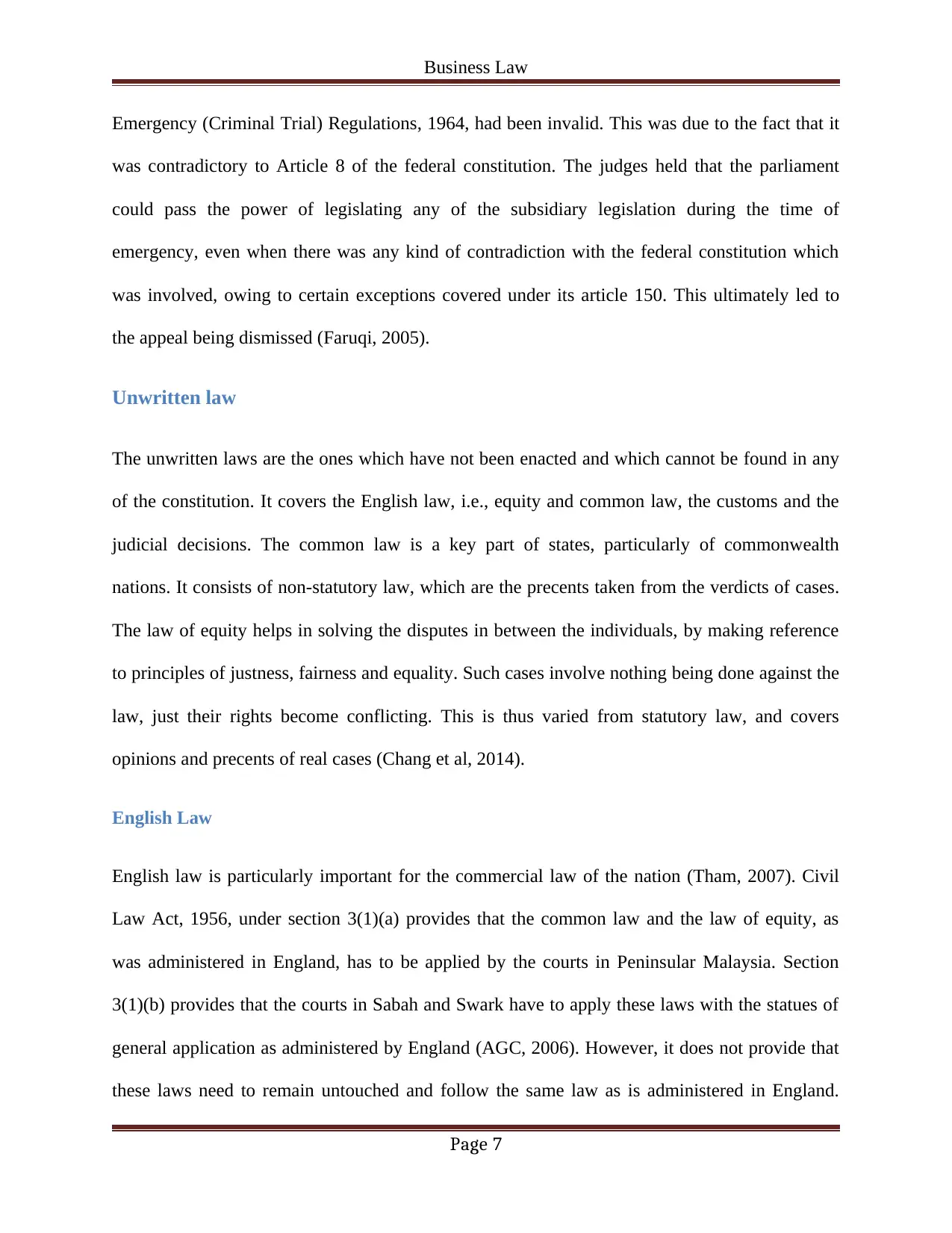
Business Law
Emergency (Criminal Trial) Regulations, 1964, had been invalid. This was due to the fact that it
was contradictory to Article 8 of the federal constitution. The judges held that the parliament
could pass the power of legislating any of the subsidiary legislation during the time of
emergency, even when there was any kind of contradiction with the federal constitution which
was involved, owing to certain exceptions covered under its article 150. This ultimately led to
the appeal being dismissed (Faruqi, 2005).
Unwritten law
The unwritten laws are the ones which have not been enacted and which cannot be found in any
of the constitution. It covers the English law, i.e., equity and common law, the customs and the
judicial decisions. The common law is a key part of states, particularly of commonwealth
nations. It consists of non-statutory law, which are the precents taken from the verdicts of cases.
The law of equity helps in solving the disputes in between the individuals, by making reference
to principles of justness, fairness and equality. Such cases involve nothing being done against the
law, just their rights become conflicting. This is thus varied from statutory law, and covers
opinions and precents of real cases (Chang et al, 2014).
English Law
English law is particularly important for the commercial law of the nation (Tham, 2007). Civil
Law Act, 1956, under section 3(1)(a) provides that the common law and the law of equity, as
was administered in England, has to be applied by the courts in Peninsular Malaysia. Section
3(1)(b) provides that the courts in Sabah and Swark have to apply these laws with the statues of
general application as administered by England (AGC, 2006). However, it does not provide that
these laws need to remain untouched and follow the same law as is administered in England.
Page 7
Emergency (Criminal Trial) Regulations, 1964, had been invalid. This was due to the fact that it
was contradictory to Article 8 of the federal constitution. The judges held that the parliament
could pass the power of legislating any of the subsidiary legislation during the time of
emergency, even when there was any kind of contradiction with the federal constitution which
was involved, owing to certain exceptions covered under its article 150. This ultimately led to
the appeal being dismissed (Faruqi, 2005).
Unwritten law
The unwritten laws are the ones which have not been enacted and which cannot be found in any
of the constitution. It covers the English law, i.e., equity and common law, the customs and the
judicial decisions. The common law is a key part of states, particularly of commonwealth
nations. It consists of non-statutory law, which are the precents taken from the verdicts of cases.
The law of equity helps in solving the disputes in between the individuals, by making reference
to principles of justness, fairness and equality. Such cases involve nothing being done against the
law, just their rights become conflicting. This is thus varied from statutory law, and covers
opinions and precents of real cases (Chang et al, 2014).
English Law
English law is particularly important for the commercial law of the nation (Tham, 2007). Civil
Law Act, 1956, under section 3(1)(a) provides that the common law and the law of equity, as
was administered in England, has to be applied by the courts in Peninsular Malaysia. Section
3(1)(b) provides that the courts in Sabah and Swark have to apply these laws with the statues of
general application as administered by England (AGC, 2006). However, it does not provide that
these laws need to remain untouched and follow the same law as is administered in England.
Page 7
Paraphrase This Document
Need a fresh take? Get an instant paraphrase of this document with our AI Paraphraser
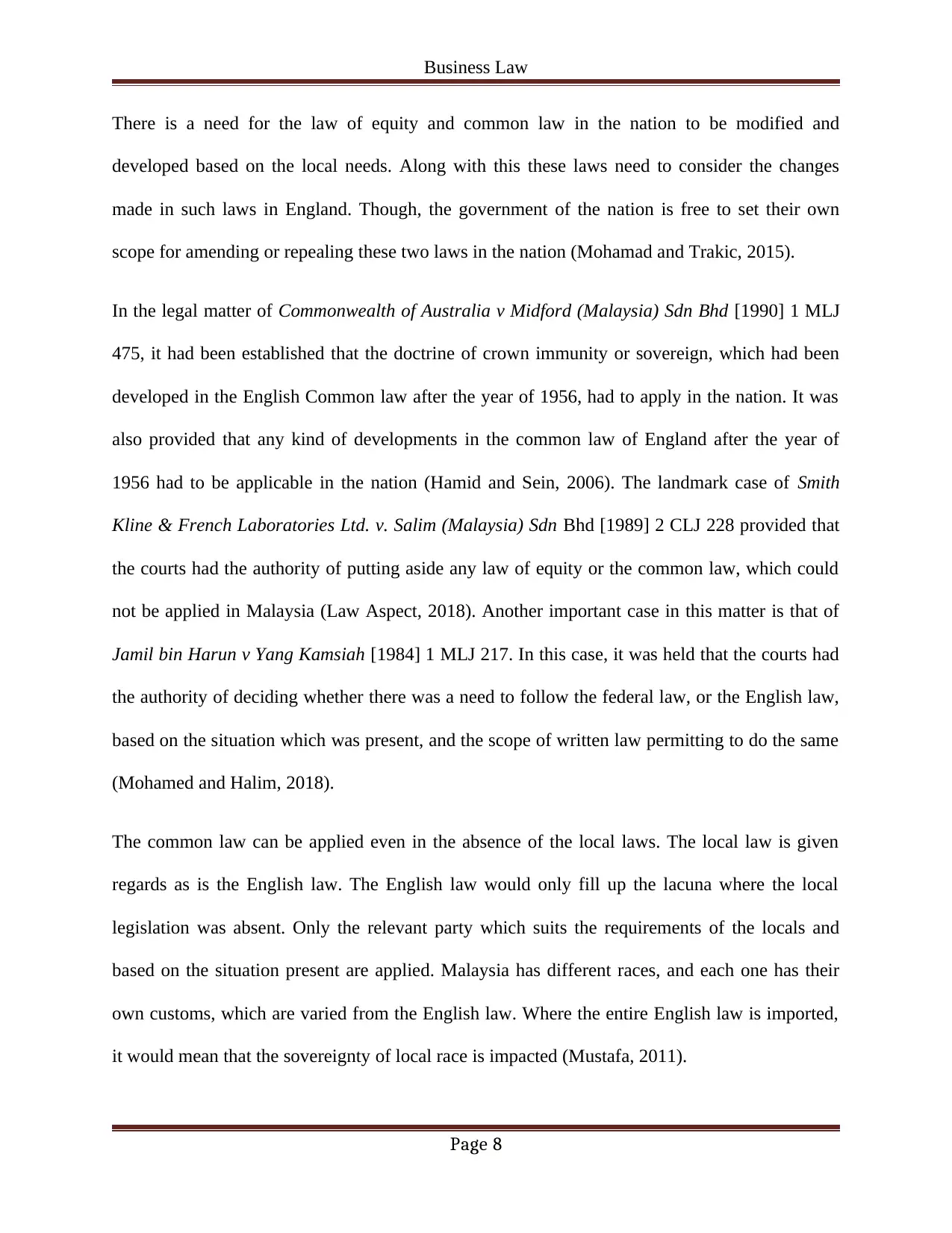
Business Law
There is a need for the law of equity and common law in the nation to be modified and
developed based on the local needs. Along with this these laws need to consider the changes
made in such laws in England. Though, the government of the nation is free to set their own
scope for amending or repealing these two laws in the nation (Mohamad and Trakic, 2015).
In the legal matter of Commonwealth of Australia v Midford (Malaysia) Sdn Bhd [1990] 1 MLJ
475, it had been established that the doctrine of crown immunity or sovereign, which had been
developed in the English Common law after the year of 1956, had to apply in the nation. It was
also provided that any kind of developments in the common law of England after the year of
1956 had to be applicable in the nation (Hamid and Sein, 2006). The landmark case of Smith
Kline & French Laboratories Ltd. v. Salim (Malaysia) Sdn Bhd [1989] 2 CLJ 228 provided that
the courts had the authority of putting aside any law of equity or the common law, which could
not be applied in Malaysia (Law Aspect, 2018). Another important case in this matter is that of
Jamil bin Harun v Yang Kamsiah [1984] 1 MLJ 217. In this case, it was held that the courts had
the authority of deciding whether there was a need to follow the federal law, or the English law,
based on the situation which was present, and the scope of written law permitting to do the same
(Mohamed and Halim, 2018).
The common law can be applied even in the absence of the local laws. The local law is given
regards as is the English law. The English law would only fill up the lacuna where the local
legislation was absent. Only the relevant party which suits the requirements of the locals and
based on the situation present are applied. Malaysia has different races, and each one has their
own customs, which are varied from the English law. Where the entire English law is imported,
it would mean that the sovereignty of local race is impacted (Mustafa, 2011).
Page 8
There is a need for the law of equity and common law in the nation to be modified and
developed based on the local needs. Along with this these laws need to consider the changes
made in such laws in England. Though, the government of the nation is free to set their own
scope for amending or repealing these two laws in the nation (Mohamad and Trakic, 2015).
In the legal matter of Commonwealth of Australia v Midford (Malaysia) Sdn Bhd [1990] 1 MLJ
475, it had been established that the doctrine of crown immunity or sovereign, which had been
developed in the English Common law after the year of 1956, had to apply in the nation. It was
also provided that any kind of developments in the common law of England after the year of
1956 had to be applicable in the nation (Hamid and Sein, 2006). The landmark case of Smith
Kline & French Laboratories Ltd. v. Salim (Malaysia) Sdn Bhd [1989] 2 CLJ 228 provided that
the courts had the authority of putting aside any law of equity or the common law, which could
not be applied in Malaysia (Law Aspect, 2018). Another important case in this matter is that of
Jamil bin Harun v Yang Kamsiah [1984] 1 MLJ 217. In this case, it was held that the courts had
the authority of deciding whether there was a need to follow the federal law, or the English law,
based on the situation which was present, and the scope of written law permitting to do the same
(Mohamed and Halim, 2018).
The common law can be applied even in the absence of the local laws. The local law is given
regards as is the English law. The English law would only fill up the lacuna where the local
legislation was absent. Only the relevant party which suits the requirements of the locals and
based on the situation present are applied. Malaysia has different races, and each one has their
own customs, which are varied from the English law. Where the entire English law is imported,
it would mean that the sovereignty of local race is impacted (Mustafa, 2011).
Page 8
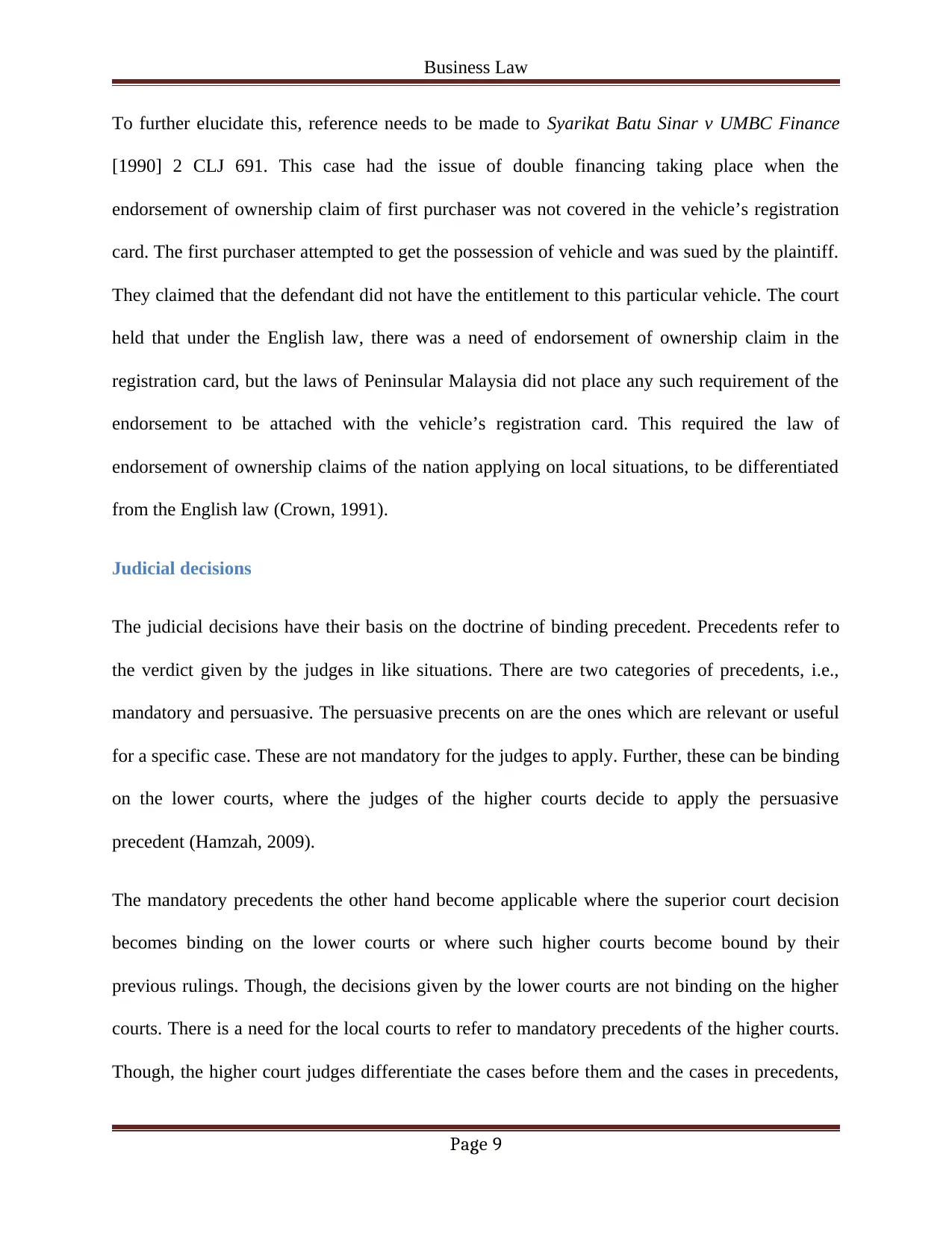
Business Law
To further elucidate this, reference needs to be made to Syarikat Batu Sinar v UMBC Finance
[1990] 2 CLJ 691. This case had the issue of double financing taking place when the
endorsement of ownership claim of first purchaser was not covered in the vehicle’s registration
card. The first purchaser attempted to get the possession of vehicle and was sued by the plaintiff.
They claimed that the defendant did not have the entitlement to this particular vehicle. The court
held that under the English law, there was a need of endorsement of ownership claim in the
registration card, but the laws of Peninsular Malaysia did not place any such requirement of the
endorsement to be attached with the vehicle’s registration card. This required the law of
endorsement of ownership claims of the nation applying on local situations, to be differentiated
from the English law (Crown, 1991).
Judicial decisions
The judicial decisions have their basis on the doctrine of binding precedent. Precedents refer to
the verdict given by the judges in like situations. There are two categories of precedents, i.e.,
mandatory and persuasive. The persuasive precents on are the ones which are relevant or useful
for a specific case. These are not mandatory for the judges to apply. Further, these can be binding
on the lower courts, where the judges of the higher courts decide to apply the persuasive
precedent (Hamzah, 2009).
The mandatory precedents the other hand become applicable where the superior court decision
becomes binding on the lower courts or where such higher courts become bound by their
previous rulings. Though, the decisions given by the lower courts are not binding on the higher
courts. There is a need for the local courts to refer to mandatory precedents of the higher courts.
Though, the higher court judges differentiate the cases before them and the cases in precedents,
Page 9
To further elucidate this, reference needs to be made to Syarikat Batu Sinar v UMBC Finance
[1990] 2 CLJ 691. This case had the issue of double financing taking place when the
endorsement of ownership claim of first purchaser was not covered in the vehicle’s registration
card. The first purchaser attempted to get the possession of vehicle and was sued by the plaintiff.
They claimed that the defendant did not have the entitlement to this particular vehicle. The court
held that under the English law, there was a need of endorsement of ownership claim in the
registration card, but the laws of Peninsular Malaysia did not place any such requirement of the
endorsement to be attached with the vehicle’s registration card. This required the law of
endorsement of ownership claims of the nation applying on local situations, to be differentiated
from the English law (Crown, 1991).
Judicial decisions
The judicial decisions have their basis on the doctrine of binding precedent. Precedents refer to
the verdict given by the judges in like situations. There are two categories of precedents, i.e.,
mandatory and persuasive. The persuasive precents on are the ones which are relevant or useful
for a specific case. These are not mandatory for the judges to apply. Further, these can be binding
on the lower courts, where the judges of the higher courts decide to apply the persuasive
precedent (Hamzah, 2009).
The mandatory precedents the other hand become applicable where the superior court decision
becomes binding on the lower courts or where such higher courts become bound by their
previous rulings. Though, the decisions given by the lower courts are not binding on the higher
courts. There is a need for the local courts to refer to mandatory precedents of the higher courts.
Though, the higher court judges differentiate the cases before them and the cases in precedents,
Page 9
⊘ This is a preview!⊘
Do you want full access?
Subscribe today to unlock all pages.

Trusted by 1+ million students worldwide
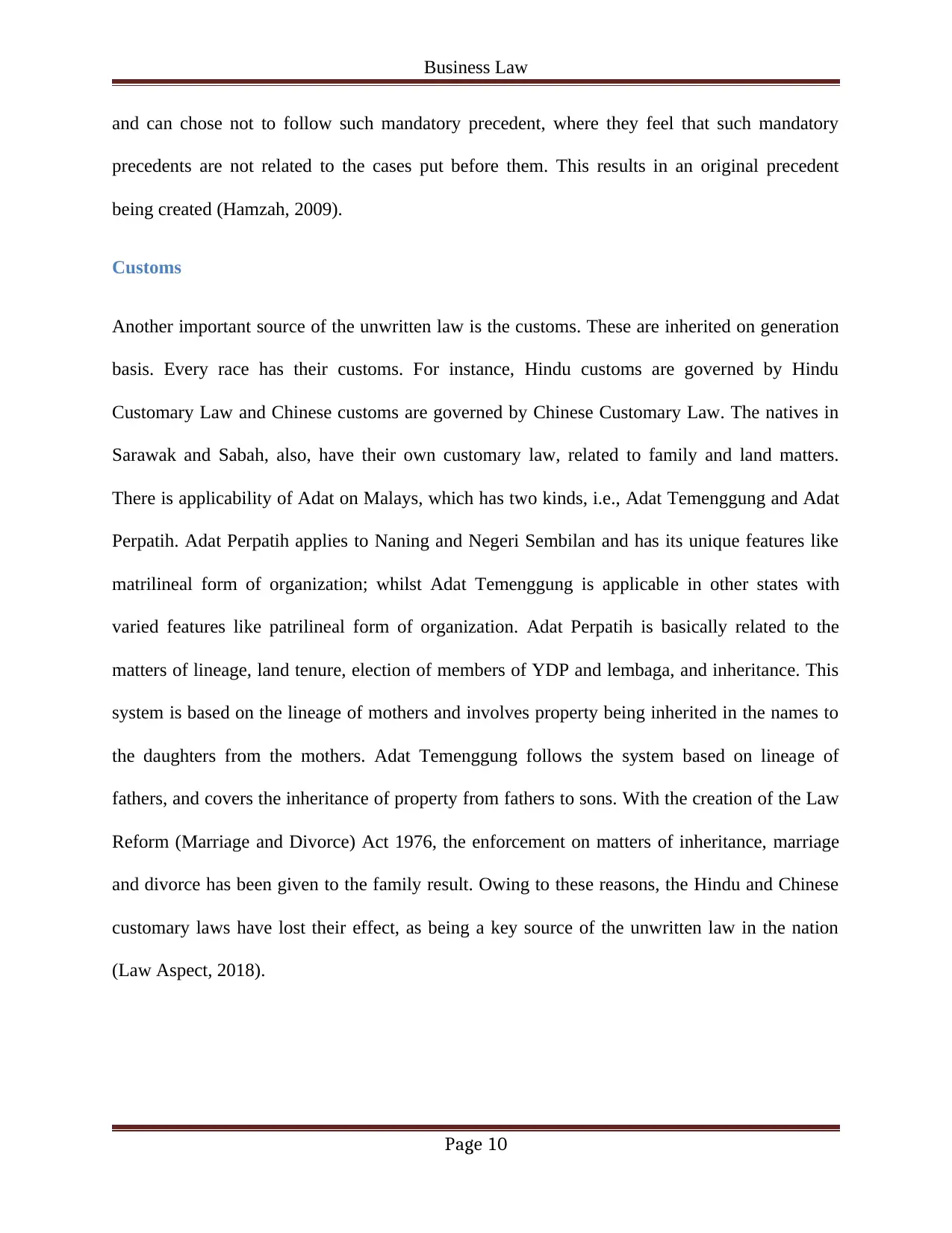
Business Law
and can chose not to follow such mandatory precedent, where they feel that such mandatory
precedents are not related to the cases put before them. This results in an original precedent
being created (Hamzah, 2009).
Customs
Another important source of the unwritten law is the customs. These are inherited on generation
basis. Every race has their customs. For instance, Hindu customs are governed by Hindu
Customary Law and Chinese customs are governed by Chinese Customary Law. The natives in
Sarawak and Sabah, also, have their own customary law, related to family and land matters.
There is applicability of Adat on Malays, which has two kinds, i.e., Adat Temenggung and Adat
Perpatih. Adat Perpatih applies to Naning and Negeri Sembilan and has its unique features like
matrilineal form of organization; whilst Adat Temenggung is applicable in other states with
varied features like patrilineal form of organization. Adat Perpatih is basically related to the
matters of lineage, land tenure, election of members of YDP and lembaga, and inheritance. This
system is based on the lineage of mothers and involves property being inherited in the names to
the daughters from the mothers. Adat Temenggung follows the system based on lineage of
fathers, and covers the inheritance of property from fathers to sons. With the creation of the Law
Reform (Marriage and Divorce) Act 1976, the enforcement on matters of inheritance, marriage
and divorce has been given to the family result. Owing to these reasons, the Hindu and Chinese
customary laws have lost their effect, as being a key source of the unwritten law in the nation
(Law Aspect, 2018).
Page 10
and can chose not to follow such mandatory precedent, where they feel that such mandatory
precedents are not related to the cases put before them. This results in an original precedent
being created (Hamzah, 2009).
Customs
Another important source of the unwritten law is the customs. These are inherited on generation
basis. Every race has their customs. For instance, Hindu customs are governed by Hindu
Customary Law and Chinese customs are governed by Chinese Customary Law. The natives in
Sarawak and Sabah, also, have their own customary law, related to family and land matters.
There is applicability of Adat on Malays, which has two kinds, i.e., Adat Temenggung and Adat
Perpatih. Adat Perpatih applies to Naning and Negeri Sembilan and has its unique features like
matrilineal form of organization; whilst Adat Temenggung is applicable in other states with
varied features like patrilineal form of organization. Adat Perpatih is basically related to the
matters of lineage, land tenure, election of members of YDP and lembaga, and inheritance. This
system is based on the lineage of mothers and involves property being inherited in the names to
the daughters from the mothers. Adat Temenggung follows the system based on lineage of
fathers, and covers the inheritance of property from fathers to sons. With the creation of the Law
Reform (Marriage and Divorce) Act 1976, the enforcement on matters of inheritance, marriage
and divorce has been given to the family result. Owing to these reasons, the Hindu and Chinese
customary laws have lost their effect, as being a key source of the unwritten law in the nation
(Law Aspect, 2018).
Page 10
Paraphrase This Document
Need a fresh take? Get an instant paraphrase of this document with our AI Paraphraser
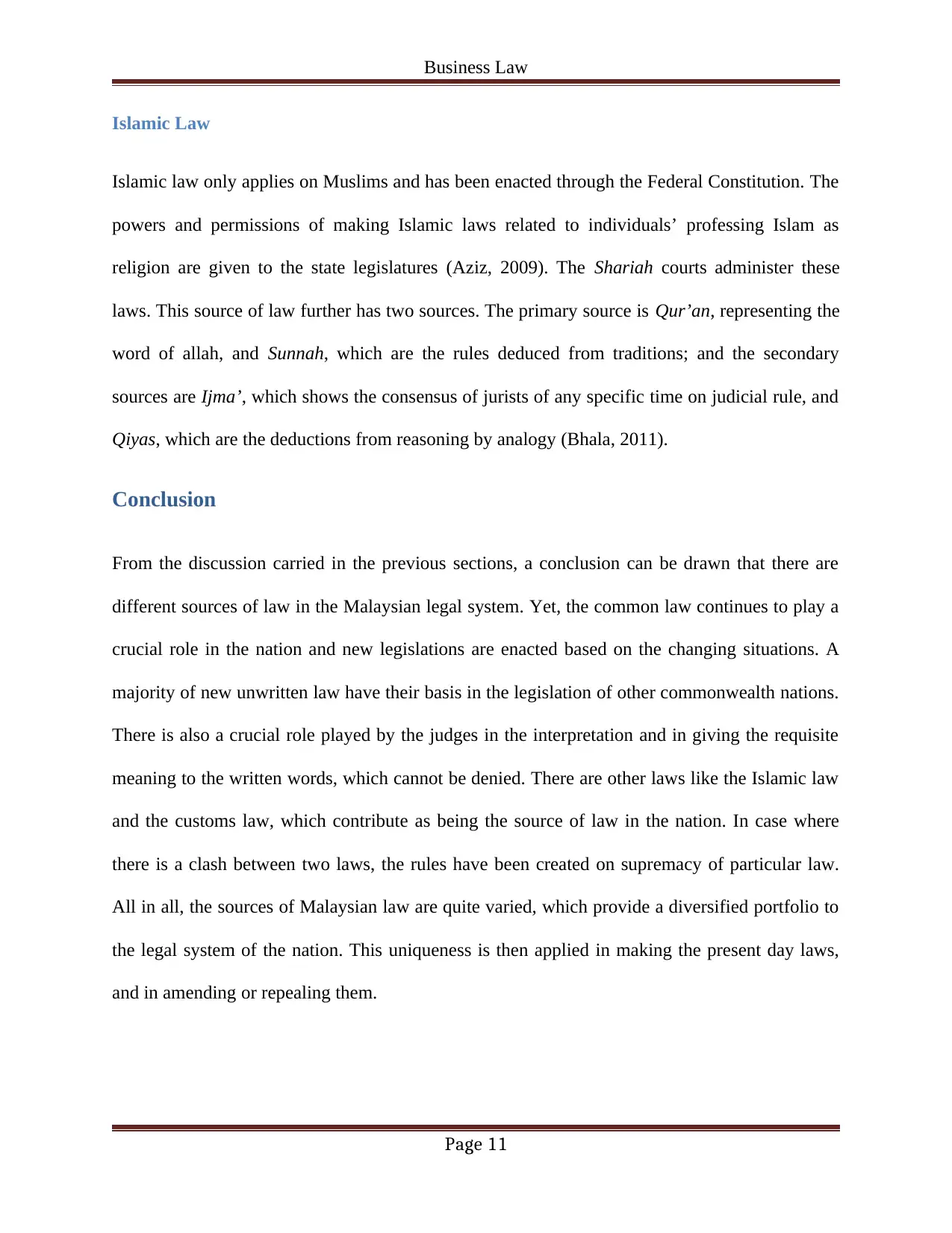
Business Law
Islamic Law
Islamic law only applies on Muslims and has been enacted through the Federal Constitution. The
powers and permissions of making Islamic laws related to individuals’ professing Islam as
religion are given to the state legislatures (Aziz, 2009). The Shariah courts administer these
laws. This source of law further has two sources. The primary source is Qur’an, representing the
word of allah, and Sunnah, which are the rules deduced from traditions; and the secondary
sources are Ijma’, which shows the consensus of jurists of any specific time on judicial rule, and
Qiyas, which are the deductions from reasoning by analogy (Bhala, 2011).
Conclusion
From the discussion carried in the previous sections, a conclusion can be drawn that there are
different sources of law in the Malaysian legal system. Yet, the common law continues to play a
crucial role in the nation and new legislations are enacted based on the changing situations. A
majority of new unwritten law have their basis in the legislation of other commonwealth nations.
There is also a crucial role played by the judges in the interpretation and in giving the requisite
meaning to the written words, which cannot be denied. There are other laws like the Islamic law
and the customs law, which contribute as being the source of law in the nation. In case where
there is a clash between two laws, the rules have been created on supremacy of particular law.
All in all, the sources of Malaysian law are quite varied, which provide a diversified portfolio to
the legal system of the nation. This uniqueness is then applied in making the present day laws,
and in amending or repealing them.
Page 11
Islamic Law
Islamic law only applies on Muslims and has been enacted through the Federal Constitution. The
powers and permissions of making Islamic laws related to individuals’ professing Islam as
religion are given to the state legislatures (Aziz, 2009). The Shariah courts administer these
laws. This source of law further has two sources. The primary source is Qur’an, representing the
word of allah, and Sunnah, which are the rules deduced from traditions; and the secondary
sources are Ijma’, which shows the consensus of jurists of any specific time on judicial rule, and
Qiyas, which are the deductions from reasoning by analogy (Bhala, 2011).
Conclusion
From the discussion carried in the previous sections, a conclusion can be drawn that there are
different sources of law in the Malaysian legal system. Yet, the common law continues to play a
crucial role in the nation and new legislations are enacted based on the changing situations. A
majority of new unwritten law have their basis in the legislation of other commonwealth nations.
There is also a crucial role played by the judges in the interpretation and in giving the requisite
meaning to the written words, which cannot be denied. There are other laws like the Islamic law
and the customs law, which contribute as being the source of law in the nation. In case where
there is a clash between two laws, the rules have been created on supremacy of particular law.
All in all, the sources of Malaysian law are quite varied, which provide a diversified portfolio to
the legal system of the nation. This uniqueness is then applied in making the present day laws,
and in amending or repealing them.
Page 11
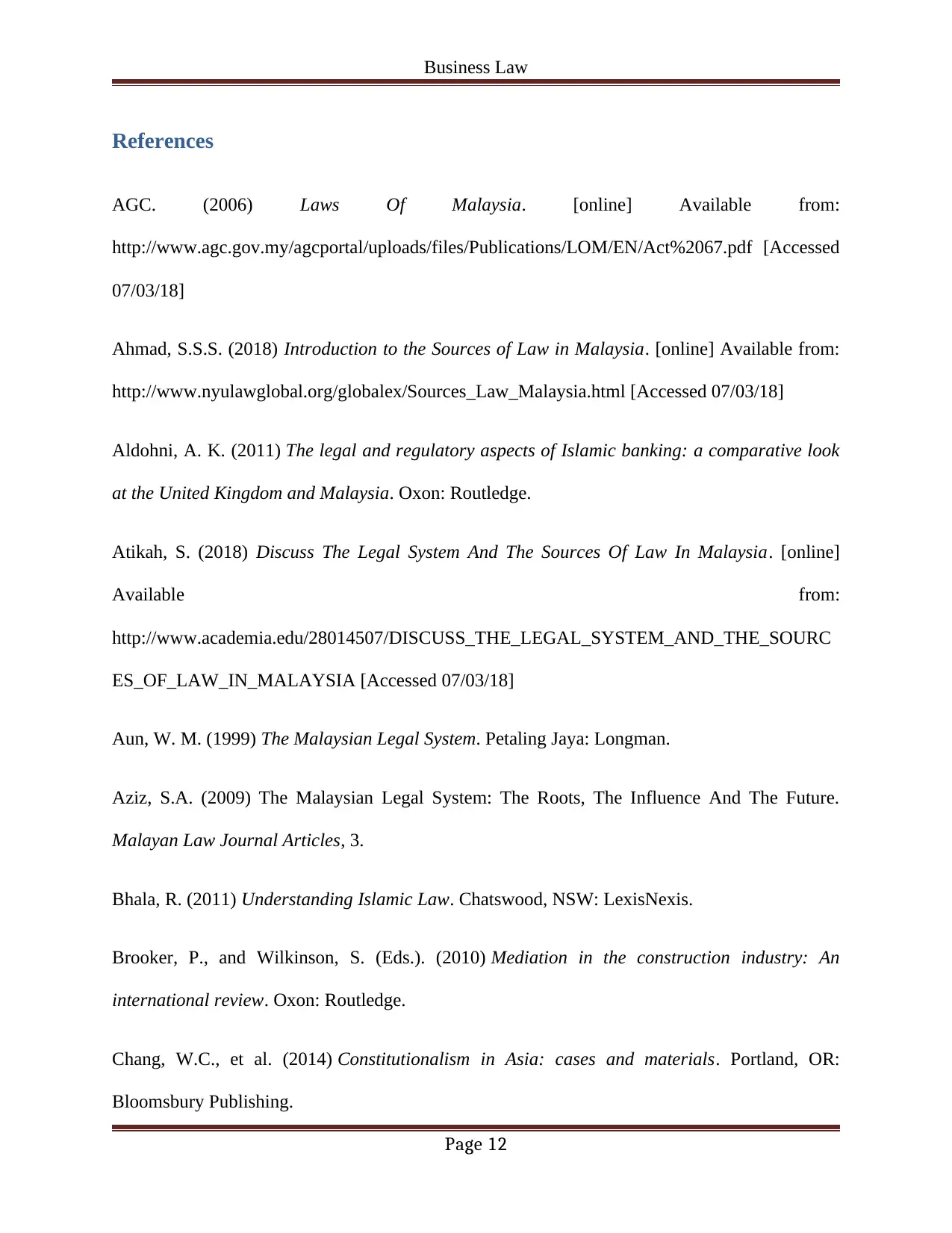
Business Law
References
AGC. (2006) Laws Of Malaysia. [online] Available from:
http://www.agc.gov.my/agcportal/uploads/files/Publications/LOM/EN/Act%2067.pdf [Accessed
07/03/18]
Ahmad, S.S.S. (2018) Introduction to the Sources of Law in Malaysia. [online] Available from:
http://www.nyulawglobal.org/globalex/Sources_Law_Malaysia.html [Accessed 07/03/18]
Aldohni, A. K. (2011) The legal and regulatory aspects of Islamic banking: a comparative look
at the United Kingdom and Malaysia. Oxon: Routledge.
Atikah, S. (2018) Discuss The Legal System And The Sources Of Law In Malaysia. [online]
Available from:
http://www.academia.edu/28014507/DISCUSS_THE_LEGAL_SYSTEM_AND_THE_SOURC
ES_OF_LAW_IN_MALAYSIA [Accessed 07/03/18]
Aun, W. M. (1999) The Malaysian Legal System. Petaling Jaya: Longman.
Aziz, S.A. (2009) The Malaysian Legal System: The Roots, The Influence And The Future.
Malayan Law Journal Articles, 3.
Bhala, R. (2011) Understanding Islamic Law. Chatswood, NSW: LexisNexis.
Brooker, P., and Wilkinson, S. (Eds.). (2010) Mediation in the construction industry: An
international review. Oxon: Routledge.
Chang, W.C., et al. (2014) Constitutionalism in Asia: cases and materials. Portland, OR:
Bloomsbury Publishing.
Page 12
References
AGC. (2006) Laws Of Malaysia. [online] Available from:
http://www.agc.gov.my/agcportal/uploads/files/Publications/LOM/EN/Act%2067.pdf [Accessed
07/03/18]
Ahmad, S.S.S. (2018) Introduction to the Sources of Law in Malaysia. [online] Available from:
http://www.nyulawglobal.org/globalex/Sources_Law_Malaysia.html [Accessed 07/03/18]
Aldohni, A. K. (2011) The legal and regulatory aspects of Islamic banking: a comparative look
at the United Kingdom and Malaysia. Oxon: Routledge.
Atikah, S. (2018) Discuss The Legal System And The Sources Of Law In Malaysia. [online]
Available from:
http://www.academia.edu/28014507/DISCUSS_THE_LEGAL_SYSTEM_AND_THE_SOURC
ES_OF_LAW_IN_MALAYSIA [Accessed 07/03/18]
Aun, W. M. (1999) The Malaysian Legal System. Petaling Jaya: Longman.
Aziz, S.A. (2009) The Malaysian Legal System: The Roots, The Influence And The Future.
Malayan Law Journal Articles, 3.
Bhala, R. (2011) Understanding Islamic Law. Chatswood, NSW: LexisNexis.
Brooker, P., and Wilkinson, S. (Eds.). (2010) Mediation in the construction industry: An
international review. Oxon: Routledge.
Chang, W.C., et al. (2014) Constitutionalism in Asia: cases and materials. Portland, OR:
Bloomsbury Publishing.
Page 12
⊘ This is a preview!⊘
Do you want full access?
Subscribe today to unlock all pages.

Trusted by 1+ million students worldwide
1 out of 14
Related Documents
Your All-in-One AI-Powered Toolkit for Academic Success.
+13062052269
info@desklib.com
Available 24*7 on WhatsApp / Email
![[object Object]](/_next/static/media/star-bottom.7253800d.svg)
Unlock your academic potential
Copyright © 2020–2025 A2Z Services. All Rights Reserved. Developed and managed by ZUCOL.





